Our new tools … have brought a new scale of opportunities to inter-thinking and inter-seeing: the condition of a truly embracing participatory democracy.
Gyorgy Kepes, ‘Toward Civic Art’, 19701Domination has its own aesthetics, and democratic domination has its democratic aesthetics. It is good that almost everyone can now have the fine arts at his fingertips, by just turning a knob on his set … In this diffusion, however, they become cogs in a culture-machine which remakes their content. Artistic alienation succumbs, together with other modes of negation, to the process of technological rationality.
Herbert Marcuse, One-Dimensional Man, 19642
Toward a human community
In 1970 Gyorgy Kepes’s Center for Advanced Visual Studies (CAVS) at the Massachusetts Institute of Technology (MIT) held its first collaborative exhibition. In a dimly lit gallery, its walls painted black, the artworks within suddenly come alive (figs.1–2). Entering the space triggers waves of motion in a forest of vibrating metal rods. Illuminated by a pulsing stroboscopic light, their harmonic oscillations mould gentle sculptural forms, like reeds in the wind (fig.3). Polarised plastic on the ground erupts in a riot of colour, the impression of each footstep recorded in vivid pooling patterns. Enormous artificial flowers billow and bend as they inflate and deflate with air. Video screens flash, lasers ricochet and a crystal-coated Mylar wall exudes a radioactive glow. The materials on view are cold and mechanical – motors, metal, vinyl and plastic, in addition to electromagnets, bulky electronics and even a telecopier machine – but with Kepes’s curatorial touch, a Midas touch, they turn into something precious and natural. Although the exhibition is technological to the extreme, it becomes organic in its metaphors.
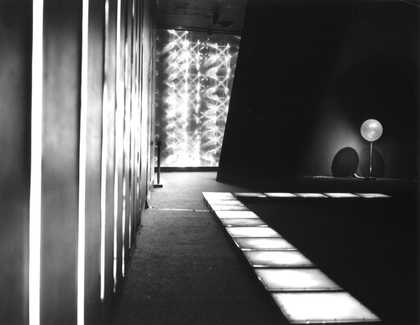
Fig.1
Installation view of Exploration, Hayden Gallery, Massachusetts Institute of Technology, 1970
Photo: Nishan Bichajian
Courtesy Center for Advanced Visual Studies Special Collection, MIT Program in Art, Culture and Technology
© Massachusetts Institute of Technology
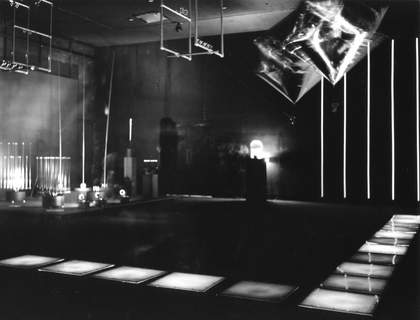
Fig.2
Installation view of Exploration, Hayden Gallery, Massachusetts Institute of Technology, 1970
Photo: Nishan Bichajian
Courtesy Center for Advanced Visual Studies Special Collection, MIT Program in Art, Culture and Technology
© Massachusetts Institute of Technology
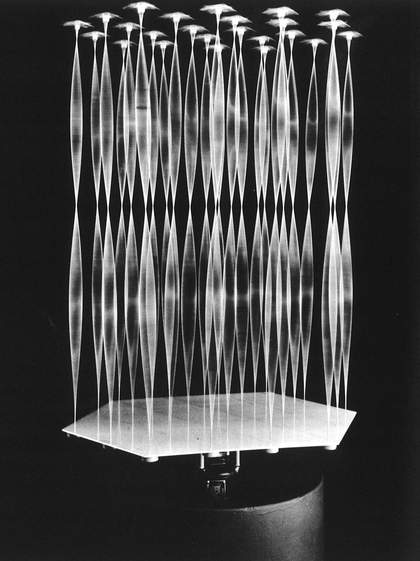
Fig.3
Wen-Ying Tsai
Cybernetic Sculpture System 1969
Printed in Explorations, exhibition catalogue, National Collection of Fine Arts, Washington D.C. 1970
The show, presented under the title Exploration at MIT’s Hayden Gallery and then in expanded form as Explorations at the National Collection of Fine Arts (now known as the Smithsonian American Art Museum) in Washington, DC, was the first project fully realised by Kepes’s Center and thus the culmination of Kepes’s ambitions for his think-tank-like art-and-science research institute, founded in 1967.3 It debuted the Center’s inaugural Fellows – Jack Burnham, Ted Kraynik, Otto Piene, Harold Tovish, Wen-Ying Tsai, Stan VanDerBeek and Takis Vassilakis – alongside other artists like Charles Frazier, John Goodyear, Newton Harrison and Les Levine.4
In organising the show Kepes rejected the standard dictates of contemporary art and its display. Not only was the white cube painted black, but there were no wall labels identifying individual artists; specific works were instead integrated into a group experience. In this way Kepes hoped to transform the show’s lifeless technology, all the electronic equipment and clunky machines, into a vibrant environment. The show’s phenomenological technics – interactive sculptures, responsive materials and ephemeral sensations of flashing light and frenzied motion – enveloped viewers in an immersive simulacrum of a natural landscape. It was, explained Kepes, like a ‘little forest’, an ‘ecological garden’, an ‘environment which is alive because of hidden forces’. This new landscape further echoed the ‘synergetic system’ of an ideal social world; it reflected, he said, ‘the dream of a human community’. Kepes believed that the aesthetics of collaboration would stimulate, or at least simulate, collaboration on a higher plane, not just between art objects or the artists who made them, but between the groups and institutions that trace ever outward from the work of art. This ‘interacting quality’, he elaborated, would produce an experience of profound interdependence and interrelation; it would be deeply ‘humane’. Kepes offered a form of aesthetic
alchemy, a transformation of science and technology
into nature, and thus – Kepes hoped – their transubstantiation.5
Kepes’s belief in art as the humane transformation of science is clear in the objects he included, which used technology to evoke natural phenomena. Takis’s quivering Signals 1967–8, blinking lights on long vertical poles, looked like ‘lily pads vibrating in the water’, explained Kepes, and Vera Simons’s modular balloons in reflective silver (Tetrahedrons, 1969) floated like billowing clouds.6 Lila Katzen’s Liquid Environment 1970 was striking: a thirty-five-foot-long tunnel covered in vinyl forms filled with bright fluorescent fluid and illuminated by ultraviolet light created a luminous, liquid space that viewers could enter (fig.4). Walking into Liquid Environment was ‘like being in the center of an opal’, one visitor reported.7 Other works in the show conveyed Kepes’s great ambition – to create peaceful global relationships – by thematising such relationships as interactive experiences between objects and viewers. His own work, for example, a walkway designed with the artist William Wainwright and titled Photoelastic Walk 1969, used plastic sheets and polarising screens to produce a captivating optical illusion (fig.5). Walking over the piece caused the refractive index of the plastic to change, revealing brightly coloured lines – ‘rainbow colors’ – that evoked the rippling effects of water in sunlight.8
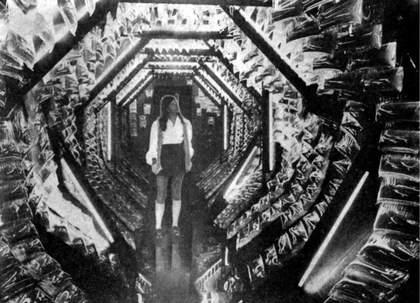
Fig.4
Lila Katzen
Liquid Environment 1970
Printed in ‘“Exploration”: Art Weds Technology’, Washington Post, 4 April 1970
Photo: Linda Wheeler
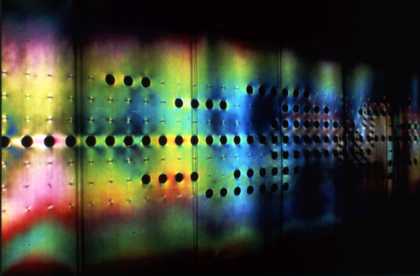
Fig.5
Gyorgy Kepes with William Wainwright
Photoelastic Walk 1969 (detail)
Photo: Nishan Bichajian
Courtesy Center for Advanced Visual Studies Special Collection, MIT Program in Art, Culture and Technology
© Massachusetts Institute of Technology and the Estate of Gyorgy Kepes
In his exhibition catalogue essay, a manifesto of sorts titled ‘Toward Civic Art’ that argued for collaborative art’s unrealised social potential, Kepes explained that these natural experiences, produced though they were through scientific and technological means, might recover a purer past and thus create a better future. Kepes used a mystical language – the language of systems. Long ago, ‘life was everywhere, in men, beasts, plants, stones, and water’, Kepes writes, conjuring the infinite circle of life: ‘The pearly iridescence of sea shells, the sparkling of a crystal, the phosphorescent glow of the sea at night, and the sunlight caught in droplights above a waterfall are all signs of an embracing, living thing … Everything is permeated by life. Everything seems in contact, interacting, interliving.’9
By mimicking these effects, the works in Explorations created ‘a dwelling for the human spirit not unlike the dimly remembered Garden of Eden’.10 Kepes envisioned his exhibition as a simulation of heaven on earth, a paradise free from original sin, a time before science and technology.
The art critical response, however, was brutal. The show garnered unusually negative reviews (Kepes called it ‘acid criticism’11 ) after it arrived in Washington, the most biting of which came from Lawrence Alloway, who saw the show as an obscene aestheticisation of science and technology and thus also an obscene perversion of art:
All the flashing lights and shimmying rods and transparent walls and silver pillows (not Warhol’s, unfortunately) fail to give the effect of art and technology reconciled, a model of order for us all. The sum of these works is a frivolous and gross fantasy of technology … Many of the technologically derived works can be placed and seem to belong in a spectrum of fantasy that runs from horror movies through comic books to science fiction … It seems clear, after ‘Explorations’ and all the other shows of this kind, that the junction of art and technology does not result in cultural lodestones, but in an art of mostly trivial effects. You feel more a part of the twentieth century by making a phone call from the Metroliner on the way home from Washington.12
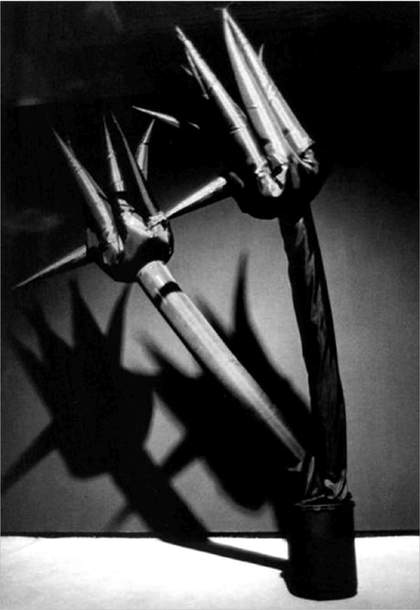
Fig.6
Otto Piene
Fleurs du Mal 1969
Printed in Explorations, exhibition catalogue, National Collection of Fine Arts, Washington D.C. 1970
Alloway targeted not only Kepes’s curatorial vision, but also the work of the artists Kepes included. Stan VanDerBeek’s grandly titled Panels for the Walls of the World 1969, a large mural that VanDerBeek created by transmitting images via fax machine from Cambridge, Massachusetts to Washington, DC during two-hour intervals three days a week, hardly impressed Alloway: ‘I can only conclude that the technical expertise here is, finally, pointless’. Neither did Otto Piene’s Fleurs du Mal 1969, a sculptural work made from inflated polyethylene and silk fabric forms (fig.6), which Alloway claimed looked ridiculous alongside all the gadgets and gimmickry: it was like ‘mutilated cacti in a mad scientist’s underground laboratory’. Most pointedly, Alloway understood the show’s ideological programme, which he considered an enthusiastic embrace of science and technology rather than their humane transformation, as an extension of the Bauhaus – and he further related the Bauhaus to fascism and the ‘managerial rationality’ of technocracy.13
Alloway, however, did not speak for the typical viewer. Explorations was a blockbuster. At MIT’s Hayden Gallery the show had, according to Kepes, ‘the largest attendance in the history of MIT exhibitions’.14 At the National Collection of Fine Arts it was ‘an extraordinary success’, as then Chief of Museum Programs, Susan Sollins, wrote to Kepes shortly after the exhibition’s opening.15 ‘According to the Smithsonian staff’, Kepes later boasted to John E. Burchard, then MIT’s Dean Emeritus of Humanities and Social Studies, ‘it has had an almost magical effect resulting in an attendance almost four times as many as at any previous exhibition.’16
But other critics agreed with Alloway. Emily Wasserman denounced Explorations as kitsch, an outright ‘failure’.17 Wasserman extended her critique beyond Alloway’s straightforward rejection of the show’s apparent enthusiasm for science and technology, and explained a more fundamental problem: the results that Kepes produced could never fulfil the goals he set out in his soaring rhetoric. Explorations ‘failed to end up looking as significant as its possibilities of cooperative design, vision, and communication suggested’.18
These critiques, so unanimous in their derision, were entirely consistent with the wider reception of other popular but polarising art-and-science and art-and-technology ventures from the period, most notably the Art and Technology Program at the Los Angeles County Museum of Art (LACMA) and the cooperative work supported by Experiments in Art and Technology or E.A.T. across the United States. As Anne Collins Goodyear has argued, the negative reception of these projects reflected in no small measure the associations attached to science and technology as instruments of war, especially as public opinion shifted decisively against the war in Vietnam by 1969.19
Yet Explorations was unique among these projects, for it was involved in more complicated debates over aesthetics and politics. Kepes opened his statement ‘Toward Civic Art’ by situating art in a very wide context (a ‘civic’ context), one that could not be confined to a gallery or museum. Collaborative forms of art making, like those at Explorations, ‘will outgrow the exhibition format and find their real territory in the dynamic life situation outside’.20 If we follow Kepes’s argument that art exists in this great system and that everything is connected to everything else (‘Everything seems in contact, interacting, interliving’), we start to spiral out of the art world and into the far more conflicted terrain beyond. It is in this context that Kepes’s exhibition becomes especially complicated.21
Kepes actually first organised the show in 1969 as the United States section for the tenth São Paulo Biennial. In this official capacity the show was to be a government-sanctioned representation of artistic culture in the US, specially packaged as a national statement for an international forum. But the exhibition was never realised in this form. After nine of the twenty-three artists Kepes had invited to participate in his collaborative venture publicly withdrew their participation that spring, Kepes was forced to cancel the show. A collaborative undertaking cannot exist without its collaborators.22
The target of the artists’ protest was Brazil’s reigning military government, which came to power in a 1964 coup d’état that replaced the democratically elected left-wing government of João Goulart and his Partido Trabalhista Brasileiro (Brazilian Labour Party) with successive right-wing dictators backed by the Brazilian military. The US, fearing that Goulart’s government was leaning precariously leftward, embraced regime change as a means of containing the spread of communism while also protecting US corporate interests. The Johnson administration even planned to secure the takeover’s success through a secret military campaign called Operation Brother Sam. Designed by the Pentagon, the White House and the Ambassador to Brazil and cold warrior Lincoln Gordon, the plan would have provided logistical support for the Brazilian military should the country have fallen into civil war as a result of the coup. Operation Brother Sam remained a contingency – Goulart was overthrown with little violence – but declassified documents have since revealed the extent to which the Johnson administration was willing to use military power in order to guarantee Goulart’s fall.23
The artists whom Kepes invited to participate and who subsequently withdrew reacted not against the clandestine circumstances surrounding the coup – these were rumoured but not yet known – but against the repressive tactics used by one of the leaders that the coup installed: President Artur da Costa e Silva, a former Army Marshal and Minister of War who, with the Brazilian military’s backing, consolidated power in 1966 as Brazil’s de facto dictator. He used this position to silence political opponents, including intellectuals. Kepes’s artists were also reacting more generally against the way in which events in Brazil seemed to mirror those in Vietnam.
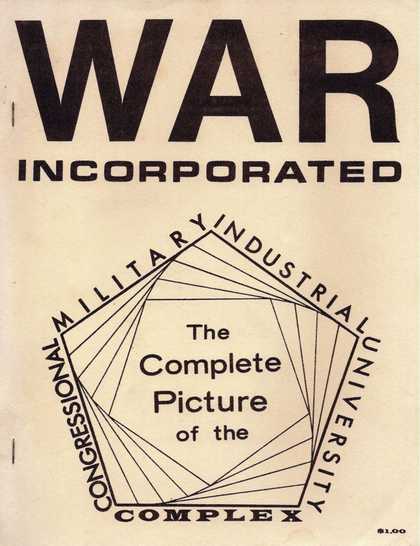
Fig.7
Cover of Janet Brown, Martin Brown, Jill Hill and others, War Incorporated: The Complete Picture of the Congressional-Military-Industrial-University Complex, Berkeley c.1970
Booklet published by the Student Research Facility, Berkeley
Collection of the author
The debate over São Paulo was thus international in scope, a matter of art as global geopolitics – a form of diplomatic statecraft that Kepes was hardly prepared to master. But it was also domestic; Kepes’s home institution, MIT, was engulfed in its own set of related controversies in the late 1960s. MIT was the archetypal ‘Cold War university’, enmeshed in the demands and dollars of the US military’s research agenda.24 As the Cold War turned hot, the links between government, military, industry and academy came into view; students and faculty began to recognise and violently reject these insidious relationships. One booklet distributed by a Berkeley-based group called the Student Research Facility identified the emergence of a frightening new formation, one aptly represented with a pentagon: WAR INCORPORATED (fig.8).25
Protest was slow to emerge at MIT – students at the Institute were not known to be especially political. Kepes referred to his own students as ‘kind of goal-oriented’ and ‘very little experimental’ – somewhat euphemistic language signifying their great technical minds but lack of humanistic focus.26 But a 1967 pamphlet published by the MIT chapter of Students for a Democratic Society (SDS), titled ‘M.I.T. and the Warfare State’, set into motion MIT’s anti-war movement. ‘MIT has indirectly become an instrument for waging modern warfare’, the pamphlet stated, noting how contracts secured through the Defense Department supported classified research at the Institute that had direct applications in Vietnam. The pamphlet emphasised how MIT’s relationships with the military generated difficult ethical questions:
MIT’s complicity in the war in Vietnam raises the issue of institutional and individual morality and responsibility. Institutions are made of men, and men must bear responsibility for their actions or non-actions. The MEN of the MIT Corporation must bear the responsibility for the technology they produce. Scientists are not instruments of society, they are MEN with conscience. Technology is not neutral, it is directed. The men who build the bombs must bear the ultimate responsibility of their use.27
The pamphlet avoided the logic common among some in the MIT community that academic work was just that – academic, entirely sequestered in the ivory tower. The most relevant passage, however, is the concluding statement, which emphasises in full capitalisation how collaboration – the particular methodology most celebrated at MIT, and the basis for the Institute’s many interdisciplinary research institutes and centers, Kepes’s included – had become synonymous with complicity. The actual word ‘collaboration’ takes on a special charge: ‘JOIN US IN DEMANDING THAT MIT ACCEPT RESPONSIBILITY FOR ITS PRESENT COLLABORATION WITH AN IMMORAL AND IMPERIALIST WAR, AND THAT FUTURE COLLABORATION CEASE.’28
Collaboration is not neutral, it is directed. But directed to what ends? This essay offers two conflicting answers. First, it elaborates a model of collaboration as complicity, making clear how Kepes’s cooperative aims became compromised. Second, it elaborates a model of collaboration as conversion, making clear how Kepes’s cooperative aims were intended to create social, cultural and political change. These two contradictory approaches were at play at the CAVS simultaneously; Kepes was deeply committed to conversion, but he could not escape complicity. The profound ideological confusion generated by the collision of these models was acute; ultimately, this debate entangled and entrapped Kepes, as it did many others in the period.
Kepes’s politics
Gyorgy Kepes is often assumed to be a fundamentally apolitical figure – an assumption consistent with the public view of MIT as a fundamentally apolitical institution. Consider a 1958 New Yorker cartoon (fig.7), reprinted in MIT’s alumni magazine, Technology Review, that parodied MIT’s faculty as technocrats, wielding their expertise for the benefit of national security: A procession of scientists in lab coats and thick glasses march to a chant in the tune of the US Marines’ official hymn: ‘From the cyclotron of Berkeley to the labs of M.I.T., We’re the lads that you can trust to keep our country strong and free.’29 Kepes certainly looked at home in this setting: he had a conservative demeanour and sartorial formality – suit and tie were his daily uniform – at odds with the popular conception of the radical artist (fig.9).

Fig.8
Frank Modell
Cartoon originally published in the New Yorker, 18 January 1958, reprinted in Technology Review, April 1958
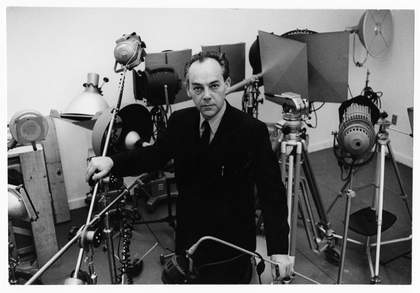
Fig.9
Ivan Massar
Portrait of Gyorgy Kepes at the Center for Advanced Visual Studies, Massachusetts Institute of Technology, 1967
Courtesy Center for Advanced Visual Studies Special Collection, MIT Program in Art, Culture and Technology
© Massachusetts Institute of Technology
And yet it would be wrong to assume that Kepes mirrored his institutional affiliation in his political positions, especially when it came to the war in Vietnam. Indeed, the archival record reveals extensive evidence of Kepes as a committed anti-war activist. Kepes supported the pacifist candidate H. Stuart Hughes, a professor of history at Harvard University who challenged Ted Kennedy in 1962 for the Massachusetts senate seat vacated by John F. Kennedy. Hughes challenged ‘liberal lion’ Ted Kennedy from the left; the core of Hughes’s platform was immediate nuclear disarmament and an end to the Vietnam War. Kepes’s name anchors ‘Hughes for Senate’ letterhead and he donated his paintings to a ‘Hughes for Senate’ fundraiser.30 Kepes was also a sponsor of the 1965 March on Washington for Peace in Vietnam, one of the earliest demonstrations on the National Mall against US intervention in southeast Asia.31 He signed an open letter to US Secretary of State Dean Rusk that condemned Rusk’s proclamations for increasing US involvement.32 He joined Scientists and Engineers for McCarthy, a group that worked for Eugene McCarthy’s 1968 presidential campaign, based almost entirely on immediate US withdrawal.33 He put his name on a statement (fig.10) in MIT’s campus paper declaring, in no uncertain terms: ‘The War in Indochina must be stopped!’34 ‘Dear Colleague’, began one letter circulated by the MIT Peace Coalition in 1973:
Peace does not come easily: Will it take one year, four years, or more before the US government ceases to bomb civilians, hospitals and other targets in Indochina?
IT IS OUR MONEY THAT FINANCES THESE DEEDS, OUR TECHNOLOGY THAT MAKES THEM POSSIBLE, OUR CONGRESS THAT AUTHORIZES THEM, OUR ARMED FORCES THAT CARRY THEM OUT, OUR PRESIDENT WHO ORDERS THEM, AND OUR WILL THAT IS INVOKED.
We must object – we must join with others to protest and use what power we have to bring this war to an end.35
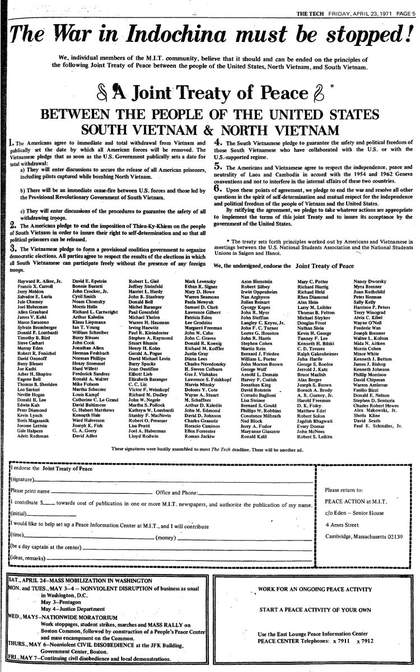
Fig.10
Advertisement in the Tech, 23 April 1971
Kepes’s name appears in the fifth column from the left
Kepes, along with tenured radicals at MIT like Noam Chomsky, signed the letter. So too did many of Kepes’s colleagues in the sciences – figures who were not always opposed to MIT’s military involvements, having themselves previously participated in them.
Petitions and protest statements are, of course, part of the 1960s ethos, and the positions Kepes endorsed were mainstream, left-of-centre positions – hardly anti-establishment. Decades later Kepes recalled with regret that he was not sufficiently ‘active’ in this opposition: ‘I was in spirit very much against U.S. involvement in Vietnam, but was not active in my resentment to the war.’36 Kepes’s regret indicates not lack of action but lack of impact, for the record is a clear indication of commitment, one previously missing in scholarly accounts.37
From theory to practice

Fig.11
‘A University Polarized around Science’
Diagram printed in Technology Review, December 1959
But how did Kepes’s politics relate to his aesthetics? To answer this question allow me to present the theory behind the Center for Advanced Visual Studies. Kepes declared his ambitions for reconciling the two cultures of art and science at his Center in the winter 1965 issue of the journal Daedalus, where he described the proposed institution as a ‘work community’ of visiting artists who would collaborate with MIT scientists on group projects.38 Kepes drew on artistic precedents, like those put forth by Bauhaus master László Moholy-Nagy, Kepes’s former mentor; Moholy’s 1947 book Vision in Motion described an ‘institute of light’ and a ‘social parliament’ that would revolve around collaboration.39 Kepes also drew on non-artistic precedents, like MIT’s own unique institutional arrangements. As early as the 1940s the Institute began forming special interdisciplinary research centres devoted to particular problems. In a report from the 1950s, MIT’s administrators visualised the Institute as a ‘university polarized around science’, with a constellation of such centres orbiting core departments but resisting the pull of specific disciplines (fig.11).40 Kepes aimed to insert the visual arts into this picture by developing a similar institution that would transcend existing departmental designations but also broader disciplines and fields of inquiry.
Kepes called his interdisciplinary methods ‘interthinking’ and ‘interseeing’.41 He described these approaches not as a focus on technological tools, but on technique itself. In an interview from the period he elaborated:
Technology today does not simply imply a physical implement, ‘a machine’ mechanical or electronic, but a systematic, disciplined, collaborative approach to a chosen objective. There is a new technology that Daniel Bell has called ‘intellectual technology’ – that is what artists must accept and understand. The medium, in this case technology, is not itself the message; it becomes a message when it is in a vital dialogue with our most authentic contemporary needs.42
But what did an ‘institute of light’, a ‘social parliament’, a new New Bauhaus, actually look like? How did the ‘intellectual technology’ of collaboration play out in practice at Kepes’s Center?
Memoranda written by Kepes and issued to the Fellows of the Center over the first few years indicate the daily problems Kepes encountered. Some were completely banal, like limited studio space, conflicting schedules, and missing equipment.43 Others were more existential: the lack of money constantly threatened to close the Center. In March 1969 Kepes sent what he called ‘an SOS letter’ to James R. Killian, then Chairman of the MIT Corporation and a former MIT President: ‘Though I tell everyone that the Center is happy and healthy, we are actually quite poor.’44 In a memo to the Fellows he bemoans the Center’s ‘shoestring existence’.45 He followed with a plea for design proposals depicting ‘large scale environmental work’ that he could use to secure funding from ‘civic and government agencies, foundations, and business organizations’.46
But many problems were more particular to the actual meaning of collaboration. Charles Frazier, for example, complained privately to Kepes that the immersive group experience envisioned for Explorations – the fact that there would be no wall labels – meant the work of other Fellows would overpower his own. Frazier even hinted that Piene’s inflated sculptures were plagiarised from his own work; in sharing his proposals in the spirit of cooperation, Frazier had created an opportunity for Piene to copy them: ‘I can’t afford to give my ideas and have them followed up by Otto’.47 Kepes was very irritated with Frazier’s comments: ‘I was troubled by your letter. I wish we could avoid any conflicts in this community for it is hard enough to survive without inner tensions.’ This interpersonal drama did not suggest to Kepes that collaboration was an inherently flawed approach. Instead, it suggested that more collaboration was necessary: ‘I assume the only way to create a mutual understanding in our common goals is to have maximum communication with each other’.48
Collaboration as complicity
Kepes managed the day-to-day issues at the Center with memoranda and curt letters, but there was also a more critical issue in advocating collaboration. ‘Intellectual technologies’ like interthinking and interseeing were, by their very definition, methodologies that would interrelate the arts with other fields – fields that were already fully compromised by MIT’s military involvements. Indeed, the term ‘intellectual technology’ that Kepes borrowed from Daniel Bell was actually a precise reference. In his 1966 book The Reforming of General Education, Bell defined ‘intellectual technology’ as shorthand for ‘the development of game theory, decision theory, simulation, linear programming, cybernetics, and operations research, many of which are tooled, as it were, by the computer’.49 In other words, these methods were all created for and used in military research and development. As Peter Galison has argued in reference specifically to cybernetics, these associations with war ‘do not so simply melt away’.50 The similarity between the Institute’s map of its interdisciplinary centres and the sinister pentagon of power representing WAR INCORPORATED is to the point (figs.10 and 6). So, too, is a spread titled ‘Spider Webs in the Ivory Tower’ from the Cambridge-based radical newspaper the Old Mole, which depicted the dizzying relationships between area universities and institutions organised by categories like ‘Finance’, ‘Government’ and ‘Major Corporations’ (fig.12).
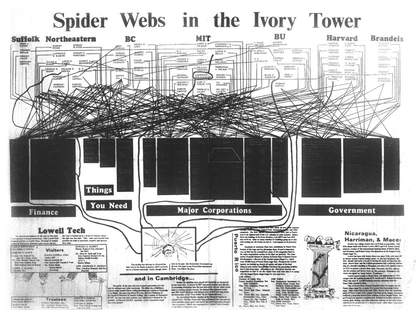
Fig.12
‘Spider Webs in the Ivory Tower’
Centrefold spread in the Old Mole, 14–23 October 1969
MIT’s connection to warfare first came into view not in May 1968 but March 1969. On 4 March that year MIT students, under the auspices of a group they called the Science Action Coordinating Committee, or SACC, joined with MIT faculty, under the auspices of a group they called the Union for Concerned Scientists or UCS, for a campus-wide ‘research stoppage’. The movement, named ‘March 4th’ in reference to the public demonstrations typifying the period (as in, to march forth in protest), replaced the day’s normal research activities with a ‘research stoppage’. The event included public discussions that revealed the extent of MIT’s participation in Vietnam, specifically through the Institute’s two ‘Special Labs’ devoted to military research and development: the Instrumentation Laboratory and the Lincoln Laboratory.51
MIT’s administration took the March 4th movement very seriously. Howard Johnson, then President of the Institute, organised a Review Panel on Special Laboratories. Named the ‘Pounds Panel’ after the panel’s chair, Dean William F. Pounds of the Sloan School of Management, the group met for many fractious public hearings. In their final report, issued that autumn, the Pounds Panel documented the startling extent of defence contracts at MIT: in 1968 $120 million, more than half of MIT’s entire annual budget of $214 million, went directly to the two Special Labs (adjusted for inflation, this translates to roughly $810 million from an annual budget of more than $1.45 billion).52 The report also itemised what all this money supported: the Instrumentation Lab used government funds to create navigation and guidance systems for NASA’s Apollo program and for the Poseidon, Polaris and Sabre ballistic missile projects. The Lincoln Lab used government funds to develop Moving Target Indication or MTI radar, a technology that could detect people in motion through foliage and was put to use in the jungles of Vietnam (it is certainly significant, given Kepes’s interests, that MTI radar is a visual technology).
It would be wrong to assume that these activities, distant as they may seem from the humanistic goings-on of a university campus, had nothing to do with art. Making such interconnections in the first place was the purpose of Kepes’s Center. Making such interconnections explicit – revealing them for debate – was precisely the point of the March 4th movement.
In fact, Kepes collaborated directly with both of the Special Labs. An entry in a daily logbook that recorded work towards the São Paulo Biennial lists Kepes’s contact with Charles Stark Draper, the founder and director of the Instrumentation Lab. Draper gained notoriety for his forceful defence of the Lab’s agenda (the Lab was renamed the Draper Lab in his honour in 1973). A notation in Kepes’s hand records a ‘phone call with director Instrumentation Lab’; Draper evidently ‘offered help, including underwriting special project expenses’. Kepes’s call occurred just weeks after the March 4th research stoppage, at a moment when Kepes would have been fully aware of the Instrumentation Lab’s activities.53 Kepes was, it might be said, making a deal with the devil.
The logbook also indicates that Kepes met with Louis L. Sutro, a scientist at the Instrumentation Lab specialising in optical technologies such as stereoscopic TV (again, a visual technology that surely intrigued Kepes). Sutro, too, ‘offered collaboration’. A later entry further indicates that Kepes, accompanied by the Fellows Harold Tovish and Ted Kraynik, visited the Lab in order to discuss possible engineering options for a series of ‘cybernetic forms’ – presumably mechanical devices that would use the principle of feedback to respond to light or sound – for inclusion in Explorations (Sutro is acknowledged in the exhibition catalogue for his contribution). Sutro planned to speak with Draper after the meeting on Kepes’s behalf ‘about sponsorship’ that might benefit Kepes’s Center. Kepes’s visit occurred two weeks after his earlier call with Draper – again, after the March 4th protest.54
These relationships were reciprocal; not only were artists appearing in MIT’s most controversial scientific contexts, but MIT’s most controversial scientists were also appearing in artistic contexts. Just that month Draper published an article in Leonardo: International Journal of the Contemporary Artist on the role of the sciences in education.55 Draper described the ‘atmosphere of creativity’ at the Instrumentation Laboratory and embraced the Lab’s ‘active projects with industry and government’ as a successful model for advanced research in science and technology. The implication was that such a model might also be used for advanced research in the arts, an idea that Draper may have borrowed directly from Kepes.56
In addition to his phone call with and visit to the Instrumentation Lab, Kepes also visited Lincoln Laboratory to meet with Jack Nolan, Group Leader of the Computer Systems division. Nolan had joined the Lab in the 1950s to work on SAGE (Semi-Automatic Ground Environment), the system of radars and anti-aircraft weapons spanning North America and powered by digital computers. In the 1960s Nolan worked on a communications system that would connect all levels of the military in a single computerised network. In a letter Nolan sent to Kepes following their meeting he enthusiastically endorsed Kepes’s interdisciplinary agenda:
I am strongly interested in the potential role of the visual arts in modern society; your new center’s explorations of the relations between art and science strike me as an important avenue toward this goal. I would appreciate any opportunity to participate in the activities of the center – e.g., in seminars, study groups, etc. – where my professional background in computer sciences and graphics may be pertinent … Again, thank you for a stimulating afternoon of discussion on a difficult but important inter-disciplinary problem.57
Kepes replied with similar enthusiasm:
The chance to have some exchange of ideas with you and your colleagues and the opportunity to see some of the work at Lincoln Laboratory was a major experience for me. Naturally, I would be most happy if you could become involved in our work.58
Kepes did not acknowledge Nolan in the Explorations catalogue and Nolan’s name does not appear elsewhere in the records of the Center’s activities; it is not clear how much Kepes actually gained from the exchange. On the other hand, Nolan had already left Lincoln Lab by 1969 in order to head the Massachusetts College of Art, a surprising career change indicative of the rapidly closing gap between the two cultures (Nolan’s interests spanned the arts and sciences: he was not only a computer scientist, but also a painter of large abstract watercolours). Perhaps Nolan’s departure from the Lab was also a way of registering protest against the uses and abuses of his expertise at MIT.59
As such correspondence indicates, interdisciplinary relationships were not just symbolic – not merely part of the sophisticated rhetoric Kepes developed to justify the Center – but also substantive. They provided opportunities for the exchange of intellectual validation (what the sociologist Geoffrey C. Bowker calls ‘legitimacy exchange’), but also actual knowledge.60 And money was changing hands: the ‘umbilical cord of gold’ famously identified by critic Clement Greenberg in 1939 as the source sustaining the modernist avant-garde was now tying together a new formation, a ‘Cold War avant-garde’ – one that was literally militaristic.61
We can trace this exchange of knowledge and money more directly to Explorations. Kepes actually wrote a memorandum to the Fellows of the Center on 4 March 1969. But the memo was not about the March 4th movement; rather, it indicates that Kepes did not participate in the research stoppage, for he was too busy working on the preparations for the São Paulo Biennial. His memo that day emphasised the importance of making a good impression on the MIT administration, specifically on James R. Killian, who had ‘reservations’ about whether the Center’s curatorial contribution would be ‘impressive enough’ to justify MIT funding. ‘As he [Killian] is the only man from the Administration who follows the art scene and its literature’, explained Kepes, ‘he also has a personal scale of values concerning the issues involved. His scale of values is not necessarily ours, but we have to recognise his attitude as an essential factor.’62 In order to secure MIT funding, Kepes asked the Fellows to flatter a figure in the administration whose ‘scale of values’ was not necessarily the same as theirs, indeed, a figure whose ‘scale of values’ was not balanced toward the arts at all; Killian was very much invested in military applications of science and technology throughout his career (he was the first Presidential Science Advisor, serving Eisenhower on issues like nuclear strategy).
Although the US contribution to São Paulo fell through, the relationships – financial and otherwise – that Kepes cultivated persisted in the form the exhibition later took. The Explorations catalogue acknowledges the show’s many industrial sponsors, noting that their offer of funds constituted ‘tangible evidence of a commitment to collaborate with artists’.63 A few of these sponsors were simultaneously supporting war-related research at MIT. The catalogue lists both Raytheon and General Electric as sponsors of the exhibition; the Pounds Panel report lists both as sponsors of the Poseidon ballistic missile project. Many other companies supporting Explorations were also beneficiaries of defence contracts and had previously or were currently engaged in military research and development, although not necessarily at MIT, among them Corning Glass Works, Fairchild Camera and Instrument Company, Honeywell, Polaroid Corporation, Sylvania Electric Products, and the Xerox Corporation.64
Collaboration as conversion
Despite the ways in which the collaboration that Kepes advocated associated him and the Fellows with the darker activities of their MIT colleagues, it would be wrong to assume that these relationships were completely compromising. In the Pounds Panel report the majority statement introduced the idea of ‘conversion’: the transformation of military research into non-military research. Conversion would maintain MIT’s commitment to scientific and technological expertise, but would use this expertise to solve new problems free of associations with war; addressing such issues would subsequently attract new, more neutral, forms of investment. The majority statement argued for incremental changes towards this goal, reassuring MIT’s wary administration: ‘It is important to note that the objective of this recommendation is not the ultimate elimination of all defense work in the special laboratories’.65
By contrast, the more radical position, one articulated in a minority statement appended to the Pounds Panel report and authored by MIT graduate student activist Jonathan P. Kabat, introduced the idea of ‘total conversion’, which Kabat defined as ‘the conversion of the laboratories and the society from wasteful to socially useful production’.66 To achieve this goal, the statement argued – perhaps paradoxically – for ‘closer ties with the special laboratories as an initial step towards conversion and the creation of a true university community’. Among these socially useful activities was the investigation of solutions for a range of problems, including ‘riots in our cities, widespread poverty and malnutrition, grossly deficient school systems, poor and inequitable medical care, urban decay, inadequate public transportation, [and] air and water pollution’.67
Total conversion was a model implicitly embraced by Kepes and actualised at his Center. The CAVS was designed to shift and shape not only the arts, but also the sciences – including, we can assume, their research agendas and funding models. In a memo to the Fellows dated October 1969, the same month that the Pounds Panel released its final report, Kepes makes this clear: ‘As you may know, there is a major shift at MIT from the emphasis on science of the last 10 to 15 years to areas which promise social contributions in a direct sense’.68 The memo asked Fellows to propose projects that could use the arts to transform science and technology in this way. The idea of conversion is likely what motivated Kepes to seek collaboration with Draper, Sutro and Nolan in MIT’s most compromised laboratories.
Of course, conversion is a highly ambiguous proposition, its direction of exchange hard to decipher. Who at MIT was converting what, and why? William Irwin Thompson, a writer and critic then teaching in the humanities program at the Institute, suggested that conversion could only fail. It would not make the sciences more humane by relating them to the arts – the point of conversion as Kepes envisioned it – but instead make the arts more inhumane by relating them to the sciences. Commenting on a symposium organised in honour of the establishment of Kepes’s Center, Thompson wrote:
In the expensive symposium in dedication to the new Center, M.I.T. was not trying to listen to the artists but was trying to beguile them with all the temptations at its disposal. The technocrats were seeking to convert the artists into new celebrants of the system; in making technological art possible, they were insuring the stability of their technological society … Men who are specialists in the management of complex organizations learn quite early that the best way to preserve the stability of powerful routines is to give on the surface the illusion of reform and constant innovation. The symposium … was just such brilliant camouflage for the ‘military-industrial complex’.69
As Thompson described it, MIT’s administration colluded with the military-industrial complex as part of a grand bargain: by generously funding the arts, the Institute justified its even more generous funding of the sciences, especially scientific activities with dubious educational value, like the work than proceeding at the two Special Labs. One culture – art – justified the corrupt activities of the other.
These debates also entered into art criticism. Writing in 1974 the art critic Jonathan Benthall described how the CAVS had ‘the opportunity to tackle and modify technological rationality on its own ground’, that is, in the context – MIT – that perfected technological rationality in the first place. Yet Benthall also explained the inherent danger with conversion: ‘As a benign foreign body planted near the core of American technocracy, the Center runs the double risk of either being rejected altogether as irrelevant, or – more subtly – of being assimilated too readily, as a public sign by technocrats that they can find space for art within their system.’70
These debates were even present in the very same issue of the journal Daedalus in which Kepes put forth his original proposal for the Center. The issue included not only essays in support of interdisciplinary exchange, compiled in a section labelled ‘On Coherences and Transformations’, but also essays against interdisciplinary exchange, compiled in a separate section labelled ‘On Disjunction and Alienation’. Here, critical theorist Herbert Marcuse offered a critique that reads as if it is addressed directly to Kepes’s comments in the journal. Building on his analysis of advanced industrial civilisation put forth in his 1964 book One-Dimensional Man, Marcuse explained how the two cultures’ conceit was a false construct, and how the unification of art and science resulted not in an equivalence between them but instead in the complete assimilation of the first culture into the second. Through interdisciplinary exchange, the arts abandon their antagonistic function and instead take on an affirmative one, serving ‘to fortify the hold of the Establishment over the mind’.71 While there had once been a time when ‘the mind could find an Archimedean point outside the Establishment from which to view it in a different light’, a place of critical distance, such a position had disappeared.72
And yet, despite offering this critique of technological rationality and its colonisation of the arts, Marcuse also suggested some possibilities – however impossible they might be to realise – for critical intervention through conversion. He argues for the ‘liberation’ of science from the scientists and hopes that ‘science would have a new function’.73 He elaborated:
One can envisage the establishment of an academic reservation where scientific research is undertaken entirely free of any military connections, where the inauguration, continuation, and publication of research is left entirely to an independent group of scientists committed to a humanist pursuit … Today, even these modest-sensible ideas are scorned as naïve and romantic, are heaped with ridicule. The fact that they are condemned before the omnipotent technical and political apparatus of our society does not necessarily demolish the value which they may possibly have.74
This ‘naïve and romantic’ hope was exactly the ambition behind Kepes’s Center.
Indeed, the idea of conversion would eventually enter into Kepes’s own rhetoric for describing the Center and its mission.75 In 1972 the Museum of Modern Art in New York held a vast international symposium organised by design curator Emilio Ambasz and titled ‘The Universitas Project’. The purpose of the event was to explore the idea of a new experimental educational institution, a Universitas, that could address the social, cultural and political crises of the late 1960s and early 1970s.76 To theorise and debate these ambitions, a wide range of intellectuals descended on MoMA, including close colleagues of Kepes’s like then former CAVS fellow Jack Burnham and some of the contributors to Kepes’s many books, such as René Dubos and Karl Deutsch. Other participants in the event like Louis Althusser, Jean Baudrillard, Manuel Castells, Michel Foucault and Alaine Touraine, reflected a new generation of critics, and they pushed back against the technocratic establishment. Kepes attempted, as best he could, to channel Marcuse. In comments made during a free-form ‘working session’, he argued for the role of the arts in creating ‘a university of subversion, an institution that faces reality and can be angry, passionately angry about issues that we have to be angry about’. He further suggested that this anger ‘has to find its focus’, that it should not be distracted by ‘technological fetishism’ but instead directed toward ‘social revolution’:
I do not speak on any political platform or anything like that, but there is a system, which evidently didn’t live up to the new demands of the scale. And the system has to be changed. And this change has to find its tools. Now, until the last maybe hundred years, there were different proposals to find the technology of change. We have different conditions now, and we have to find a different technology of revolution.77
Kepes avoided any direct ‘political platform’ but also advocated for a form of ‘revolution’. These contradictory statements indicate the difficulty he had in balancing politics and aesthetics at a moment of intense dissension.
‘Political Issues Sao Paulo’
I have elaborated two very different models for collaboration: one based on complicity and one based on conversion. How did the conflict between these two models play out at the Center? Returning now to São Paulo and Explorations, it becomes clear that there was a contest of meaning over the very term ‘collaboration’. The many artists Kepes invited to participate in his exhibition grappled with the model that Kepes put forth and what it actually represented. They both embraced but also rejected collaboration; like Kepes, they were tied in a dialectical knot, actively struggling to understand what working together was and could be.
In the Center’s archives, in a folder labelled ‘Political Issues Sao Paulo’, a pile of letters addressed to Kepes reveals the intensity of this struggle. The first is from Hans Haacke, the first artist to withdraw from the exhibition:
The U.S. Government is fighting an immoral war in Vietnam and is vigorously supporting fascist regimes in Brazil and in other parts of the world. At present any exhibition under U.S. Government auspices is designed and/or liable to promote the image and the policies of this government. It becomes a tool of international public relations, irrespective of the honorable intentions of the organisers and participants. With repressive tolerance the energies of artists are being diverted into serving the needs of a policy that these very artists rightfully despise. If they do not want to become involuntary accomplices they have no choice but to refuse the showing of their work in a national representation abroad.78
Kepes respected Haacke’s decision, but his reply also made the case that collaborating was always preferable to not collaborating: ‘if one has strong convictions of the validity of one’s work, wherever and under whatever circumstances one presents one’s works doesn’t matter’.79
Haacke’s letter, shared with artists in the US and Europe, set off a flurry of protests against the Biennial, especially in France. American critic Dore Ashton, then in Paris, sent a letter to Kepes arguing that withdrawal would be ‘a great gesture of solidarity with artists all over the world’, specifically for artists who ‘have hoped that the power of America invested in her art as well as her less innocent pastimes’ could be used ‘for once in concert with the forces of good on an international scale’.80 French critic Jean Clay explained to Kepes that Brazilian expatriates then in Paris (he cited Lygia Clark and Hélio Oiticica, among others) were opposed to participation. He described ‘how art is used’ in Brazil – or, really, misused – to legitimate the powerful.81
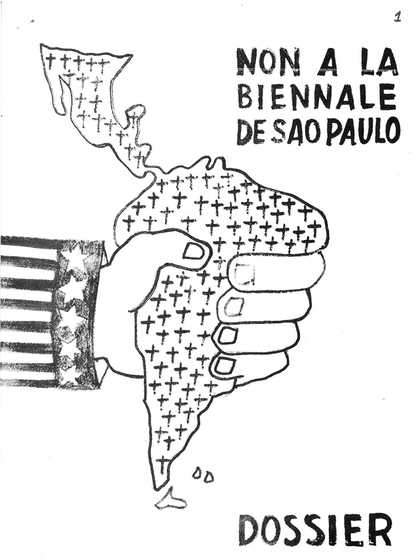
Fig.13
‘Non a la Biennale de São Paulo Dossier’ 1969
Julio Le Parc Archive
Courtesy Center for Advanced Visual Studies Special Collection, Massachusetts Institute of Technology
To make his case Clay sent Kepes an anonymous dossier of statements from European artists with a startling image on its cover (fig.13): the hand of Uncle Sam – or, more accurately, given what is now known about the 1964 coup, ‘Brother Sam’ – grasping for Latin America. The documents within include a famous letter from Oiticica that had initiated the protest against French representation in São Paulo. The letter argued that to participate in the Biennial was to support ‘blind fascist ideas and ideals’.82
In response, Kepes drafted his own statement affirming the aesthetics of collaboration. He planned to circulate the statement to newspapers and magazines in the US and Brazil, and although it never ran in the press in full, it was quoted by critic Grace Glueck in an article on the boycott in the New York Times.83 The text reveals how much Kepes agreed with the movement’s reasons for not participating even while he embraced participation as a necessary means of action:
We at the Center seek to emphasize not divergences, emphasized by today’s ego-oriented art world, but rather convergences, common denominators, community … We believe that in the long run our chance to communicate deeply-held ideas without compromise can have a far greater possible impact on Brazilian life than can be accomplished by a boycott and also could best contribute to the international, cultural commonwealth … We recognize the justification of confrontation with all inhuman political power systems, but we deeply feel that this must complemented by constructive, life-building efforts. There is an old Chinese saying that it is better to light a single candle than to curse the darkness.84
Kepes used the metaphor of light to assert collaboration as the only means of politics; for him, to not participate was to protect the status quo. He was unable to imagine that collaboration might be co-opted in any way.
The statement prompted very polarised reactions. On the one hand it was far too political for MIT’s administration, which was not happy about Kepes’s discussion of power, even though Kepes tactfully avoided addressing MIT in any direct way. Presumably in reference to Kepes’s description of ‘the justification of confrontation with all inhuman political power systems’, MIT President Howard Johnson circulated Glueck’s article to MIT’s Provost, Jerome Wiesner, with an attached memorandum: ‘I see Kepes kept the one ¶ [paragraph] we had doubts about + of course it was quoted.’85
On the other hand, the statement was not political enough for Kepes’s critics, namely Jean Clay, who disagreed less with the content of the statement than with the statement itself – the idea of communication as an effective means of creating change: ‘You will have it in the north american [sic] catalogue. Very good! But who will read that? A few hundred, rather rich, people – no more … you will not have any ability to publish it in Portuguese in any paper’.86 As Clay indicates, communication is always controlled and contained by outside forces.
Around a week before he composed his statement on the Biennial Kepes also wrote to CAVS Fellow Vassilakis Takis.87 Takis and Kepes shared a common belief in interdisciplinarity and a similar perspective on political issues, but they often had differing ideas about how to realise these goals. Kepes’s letter makes clear how carefully he was considering his options and their ramifications:
I am certain that if the aspiration of the Center is expressed convincingly … we could contribute more constructively to the Brazilian and the international artistic community than by withdrawing our participation. But I have no illusions; naturally no matter how well we express our ideas … it will inevitably be seen in the context of the total present political situation. For some people, no doubt, participation in an international exhibition in a country which is under brutal military dictatorship could be read as an approval of the regime.88
Kepes was still in denial, however: he continued his letter with a declaration of the ‘facts’ of the Biennial, but these facts were more aspirational than actual. He declared, for example, that the US section ‘is organized by our Center without any strings attached. It is not a government exhibition but is cosponsored by the Smithsonian and MIT’. Yet the Smithsonian is, of course, a government institution, and as the March 4th movement had already made abundantly clear, MIT was very much entwined with the government.
In an attempt to bolster his political credentials Kepes built his case for communication with yet more communication. As he explained to Ashton, he reached out to Brazilians whose ‘political stands ranged from the far left through the various shades of liberals’.89 Remarkably, he obtained a letter from Brazil’s former president Juscelino Kubitschek (João Goulart, the Brazilian leader ousted in the 1964 coup, had served as Kubitschek’s Vice President in the 1950s).90 Kubitschek endorsed US participation without reservation. ‘In short’, wrote Kubitschek, ‘I consider the representation of the Center of Advanced Visual Studies [sic] at the Sao Paulo Bienal to be of the greatest importance’.91 The fact alone that Kepes was able to obtain Kubitschek’s letter is astonishing; Kepes had long hoped for ‘civic art’, and here he was communicating with a former world leader. The letter is also astonishing in revealing that a Brazilian opposition figure – Kubitschek was blacklisted after the 1964 coup and briefly exiled from the country – endorsed US participation in the Biennial even while artists worldwide protested against it.
In an attempt to bolster his political credentials still further, Kepes also had his name appended to a telegram sent directly that spring to President Costa e Silva, the Brazilian dictator, denouncing Costa e Silva’s repressive policies (the telegram was significant because Lincoln Gordon, the architect of Operation Brother Sam, also signed it – even though he had previously supported the coup that installed Costa e Silva). Prompted by the forced retirements of sixty-eight academics accused of radical leftist sympathies, the telegram decried the ‘massive expulsion of Brazilian professors and scientists from their universities’ and defended ‘academic freedom, democratic procedures and the integrity of the sciences and humanities’.92
But Kepes’s letter from Kubitschek and telegram to Costa e Silva made little difference in his efforts to save the exhibition and appease the remaining Biennial participants. Soon, letters from other artists announcing their decisions to withdraw from the exhibition arrived at the Center. The most damning (and oft-quoted) was Robert Smithson’s:
To celebrate the power of technology through art strikes me as a sad parody of NASA. I do not share the confidence of the astronauts. The rationalism and logic of the engineer is too self-assured. Art aping science turns into a cultural malaise. The righteousness of ‘team spirit’ is no solution for art … I am sick of ‘lighting candles,’ I want to know what the ‘darkness’ is … As rockets go to the moon the darkness around the Earth grows deeper and darker. The ‘team spirit’ of the exhibition could be seen as an endorsement of NASA’s Mission Operations Control Room with all its crew-cut teamwork … If technology is to have any chance at all, it must become more self-critical. If one wants teamwork he should join the army. A panel called ‘What’s Wrong with Technological Art’ might help.93
Other letters were less forceful but nonetheless compelling. John Goodyear used his communication with Kepes as an opportunity to reflect on the nature of communication itself, arguing that communication is never transparent; once it enters the world, it can be changed and manipulated.94 Still other letters indicate that some artists instead supported participation in the exhibition. Newton Harrison, for example, argued that forcing artists to withdraw was hypocritical: ‘A work of art is an exercise in freedom. To remove this exercise from an environment already significantly lacking freedom serves only to give power by default to that which I/we disagree with. Showing these works in Brazil is perhaps more important now than at another less critical time.’95 Charles Frazier agreed: ‘the “Fascists” have won the day. Not only have they succeeded in silencing their own artists, now with the help of the withdrawing artists from other nations, they have strangled the cry of outrage that might have rung out defiantly from within their own frontiers to the embarrassment and shame of the present regime.’96 Other artists also condemned what they perceived as the orthodoxy of the New York art world: ‘I find the politicing [sic] of certain artists connected with the show no more desirable than the politics of the Brazilian Government’, wrote Les Levine.97

Fig.14
C.D. Everdell
Cartoon published in the Old Mole, 26 September–9 October 1969
In the end, the tiresome letter writing, the endless back and forth, the chain of statements and counterstatements, all added up to nothing. The Old Mole ran a satirical cartoon that humorously parodied the situation, a common one that year; it shows talking heads ensconced in a bell jar, like the type that might contain a rare specimen for display (fig.14). The chattering class jabbers and babbles; words like ‘rational’, ‘dialogue’, ‘proposal’ and ‘report’ float above.
But ultimately there simply were not enough participants to justify an exhibition. Kepes had the final word:
We feel as deeply concerned at the lack of creative and democratic liberties as those who have withdrawn, and the intention of the fourteen of us had been to participate in the exhibition and place on record our deep resentment against cultural suppression. To our great disappointment we have to conclude that our basic concept to create a community exhibition has been crippled by the withdrawal of nine participants of the community.98
After withdrawing from São Paulo Kepes was pragmatic. He worked to guarantee that the exhibition could still be realised, if in modified form, at MIT and at the National Collection of Fine Arts. Concerned ‘about the artists’ political moodiness’, he would screen participants more carefully.99 But he was truly devastated by the events.100 The episode refuted his essential ambition, for it made clear that collaboration could not create the type of change Kepes originally imagined possible. In a letter to Jerome Wiesner that summer he disclosed a profound disappointment:
Now in the aftermath of all the struggle and tensions, I am tying up the loose ends and ‘burying the dead.’ I am sure you know that it was not an easy time for me. I had a great deal of hopes and expectations for the Sao Paulo Exhibition and confidence that we could make a real contribution, and am heartbroken about the way things developed.101
Kepes lamented the ‘hopes and despairs of the Center’, elsewhere describing the São Paulo Biennal as a ‘rather rough trial’, a ‘taxing’ ordeal.102 For him, it was a failure.
Kepes’s faith
In the autumn of 1969, after Kepes had ‘buried the dead’, he resolved to give new life to the Center. He wanted redemption. He wanted ‘to offer something to MIT which would be meaningful’.103 He planned to open the Center’s doors to the community at large for a series of collaborative seminars, the goal of which would be ‘to stimulate communication and exchange of ideas’.104

Fig.15
Cover of the Old Mole, 7–20 November 1969
Collection of the author
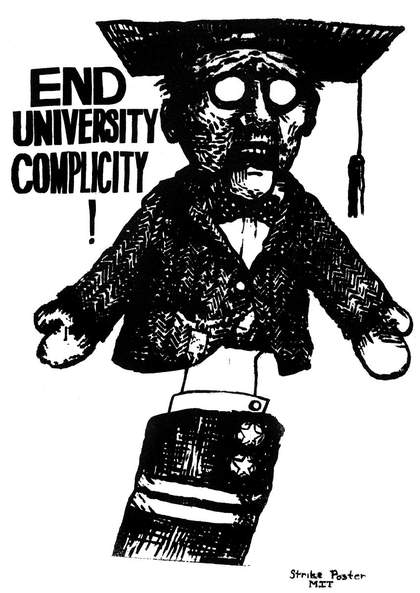
Fig.16
Strike poster made for a MIT student protest, published in the Old Mole, 15–28 May 1970
The atmosphere on campus that autumn was tense. Violent protest erupted in November as police brutalised students assembled in protest at the Instrumentation Laboratory. Later that month, the Old Mole ran a cover (fig.15) showing MIT students unfurling the flag of the National Liberation Front over a balcony in the grand lobby of MIT’s historic Rogers Building (Kepes’s home at MIT); the cover was accompanied with a headline evoking the chants heard across campus: ‘6 5 4 3 LET’S SMASH MIT!’. A strike poster made by students and later reproduced in the newspaper shows the MIT faculty as empty suits, as tweed puppets with no eyes, easily manipulated by Uncle Sam (fig.16).
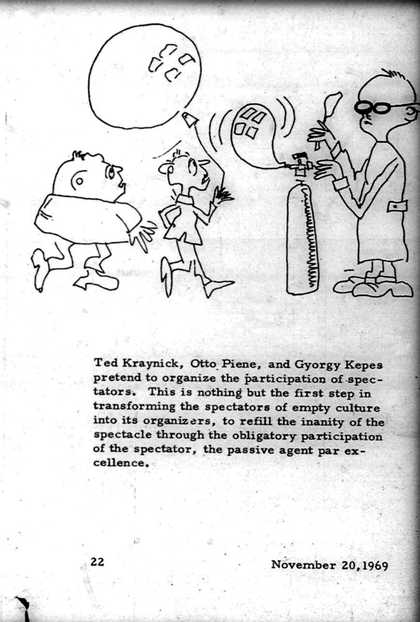
Fig.17
Pamphlet created by the Council for Creative Existence (CCE), 1969
Gyorgy Kepes Papers, Archives of American Art, Smithsonian Institution
It was not a good time for yet another ‘exchange of ideas’. After leading a seminar at the Center that November, CAVS Fellow Otto Piene discovered a pamphlet left behind by a visitor. It was signed by a mysterious group: the ‘Council for Conscious Existence’ (CCE).105 The leaflet caricatured another CAVS Fellow Kraynik, Piene and a brainy Kepes, in a lab coat and thick glasses, as they filled balloons with helium (fig.17). The drawing refers to Piene’s ongoing development of what he called Sky Art. Piene used massive balloon-like forms made of polyethylene and inflated with helium or hot air to create outdoor environmental sculptures. Sky Art exemplified the Center’s collaborative mission, for Piene developed it through a cooperative exchange with an MIT astrophysicist named Walter H.G. Lewin.106
Piene’s Sky Art had become a recurring feature of the MIT landscape. Just weeks prior, on 15 October, Peine presented his sculptural forms at a massive protest called the Moratorium to End the War in Vietnam. Long, rainbow-like balloon arches, inscribed with the words ‘Peace’ and ‘Paz’, floated hundreds of feet in the air. They guided the MIT community from the steps of the Rogers Building, across the Harvard Bridge, to the Boston Common, where more than 100,000 students, members of faculty and protestors gathered (fig.18). The image in the CCE pamphlet rejected Peine’s Sky Art – like all the ‘dialogue’ advocated that year in Cambridge – as so much hot air.

Fig.18
Protestors cross the Charles River under Otto Piene’s Sky Art during the Moratorium to End the War in Vietnam, 15 October 1969
Printed in Technique, vol.86, the Massachusetts Institute of Technology Class of 1970 Yearbook
The text within the pamphlet is obscure and obtuse. It uses the dense constructions of neo-Marxian prose to condemn the Center’s balloon activities as a spectacle of science and technology, and as Spectacle, in the Debordian sense. The pamphlet, adapted from one of the founding treatises of the Situationist International, reads:
As artists throw up ever more monstrous representations of the society of emptiness, one point is unmistakable: the next revolution in art must be the art of revolution, the transformation of everyday life. In the laboratories of individual creativity, a revolutionary alchemy transmutes into gold the most vile metals of everyday-lifeness. Its concern before anything else is to dissolve consciousness of constraints, that is to say the sentiment of impotence; in the attractive exercise of creativity to melt the constraints in the burst of creative power, in the serene affirmation of its genius.107
What was this curious group? The CCE was comprised of disaffected students and led by a former Columbia University PhD candidate named King Collins; in response to Students for a Democratic Society, which he considered too centrist, Collins had formed a group called the Radical Action Cooperative (RAC) at Columbia in 1968. He later renamed it the CCE.108 To penetrate the heart of American higher education, Collins and his coterie travelled from New York to Cambridge, where they put Situationist theory into practice through critical interventions.109 Two members of the CCE, Wilma and Sid Lewis, decided to stage just such an intervention against Kepes and his Center, and the pamphlet discovered at the Center was the result.
The pamphlet is striking in part because the CCE’s stated mission mirrors that of the CAVS – their similar bureaucratic acronyms are suggestive in themselves. Kepes’s rejection of the museum context as commercial could be understood, perhaps, as an interest in the ‘transformation of everyday life’. His work with scientists was a retreat, perhaps, to the ‘laboratories of individual creativity’. Conversion, at least as Kepes theorised it, was a form of ‘revolutionary alchemy’. The pamphlet even used the metaphor of light as enlightenment, an idea at the core of Kepes’s philosophy.
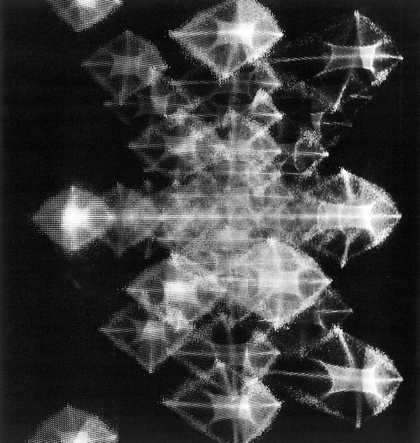
Fig.19
Ted Kraynik
Video-Luminar Light Mural 1969 (detail)
Printed in Explorations, exhibition catalogue, National Collection of Fine Arts, Washington D.C. 1970
Such commonalities were completely lost on the CCE. They instead offered a contemptuous critique of Kepes’s Center, with a brief commentary directed to each artist depicted in the pamphlet’s cartoon image.110 The first, addressed to Ted Kraynik, quotes a description of his Video-Luminar Light Mural 1969, a work presented at Explorations; viewers could interact with the work through a series of closed circuit cameras and video monitors that produced an abstract pattern in response to viewers’ movements (fig.19). The CCE understood this participation as akin to ideological interpellation, a means of suturing the viewer into Spectacle; by capturing the viewer’s movement in a technological apparatus, the work put the viewer under the control of technological rationality. They wrote to Kraynik:
You are syphilis, a plague eating into consciousness; and having accepted your own half imitation of life, you ask us to join you in the anti-chamber [sic] of the cybernetic welfare state. You are even so arrogant, so infected with your own urine, that you present us with images of our own destruction.111
The second commentary, addressed to Piene, offered a direct critique of his remarks at the Center’s founding symposium. He had argued that ‘the greatest service technology could do for art would be to enable the artist to reach a proliferating audience’ through new tools, like television. The CCE did not accept this proposition:
You are the advanced guard of the cybernetic welfare state – the reconsecration of order, no longer with God as ruler, but with technology raised to myth in the perfect order of zombies. You are not an artist; you are a WHORE for power, decorating the society of consumption – not for just the jaded ruling class but for everyone. You are so benighted that you publicly suggest the use of TV so that all can ‘participate’ in the unilateral reception of images of their own alienation.112
Lastly, the pamphlet delivered a single line of invective to the Center’s founder: ‘And to you, Gyorgy Kepes whose dream it was to gather this scum, fuck you’.113
The pamphlet is hilarious but its deadpan tone is also horrifying. In response, both Kepes and Piene offered carefully worded rebuttals. Even this extreme attack did not alter Kepes’s faith: he reiterated his standard line, one repeated in the face of all conflicts. He calmly invited the other side to collaborate: ‘If you are sincerely interested in the problems of our time, and the artist’s role in the modern world, it may be profitable for both of us to have an exchange of ideas concerning these issues. Please call me at a time convenient for you so that we can sit down and give each other a chance to exchange points of view.’114
Piene similarly offered to open up a conversation, but unlike Kepes, he also pushed back, rejecting the CCE’s caricature of the Center’s aesthetics and politics. ‘After reading your pamphlet I wonder why you did not sit down and discuss it with us. I could have easily corrected a number of obvious misunderstandings. Besides that I am interested in “the art of revolution.” Are you a group of reactionary conservatives in fashionable disguise?’115 Piene’s letter perfectly captures the ideological confusion of the period. But the CCE would not meet. They had no interest in collaboration. Wilma Lewis wrote a final reply to Kepes: ‘Your head is in your ass. We have not misunderstood. When there is no secretary to type your letter, perhaps then, scum, you will understand.’116
Nothing more came of the exchange. The pamphlet was ultimately forgotten, the letters were filed away. Kepes was resolute; life at the Center had to go on. What is most remarkable about Kepes is his relentless faith. While other artists would have taken the far easier path of denouncing MIT’s technocratic culture, of condemning the military-industrial-aesthetic complex, Kepes instead remained part of that culture, even though he resented what it represented. He hoped – naively, romantically, and also admirably – to change this culture through collaboration alone. For this faith – a deeply utopian one, as it turns out, for collaboration’s efficacy was disproven time and again – Kepes withstood an onslaught of vitriol. This suffering did not alter Kepes’s devotion to the possibilities of working together.
